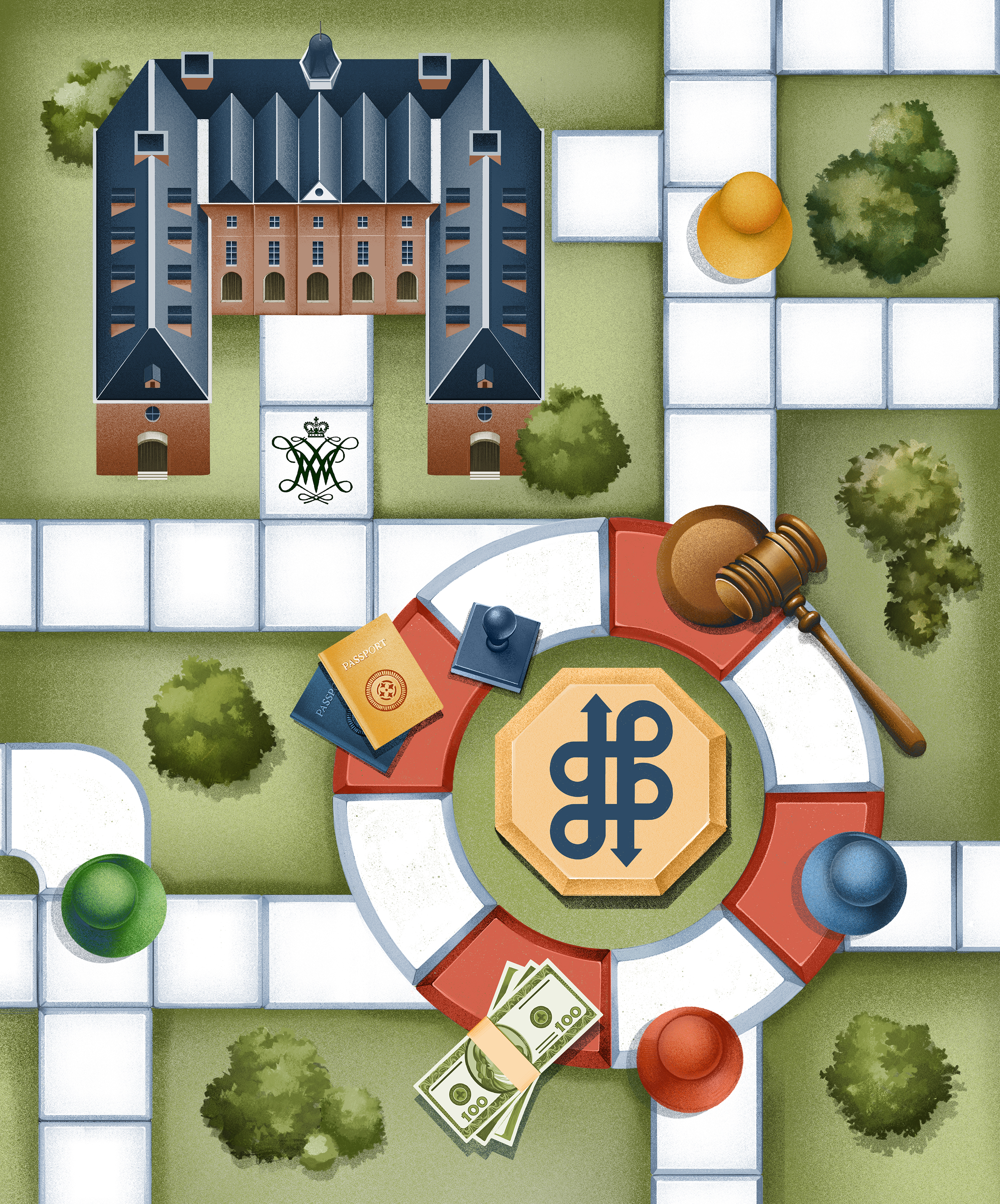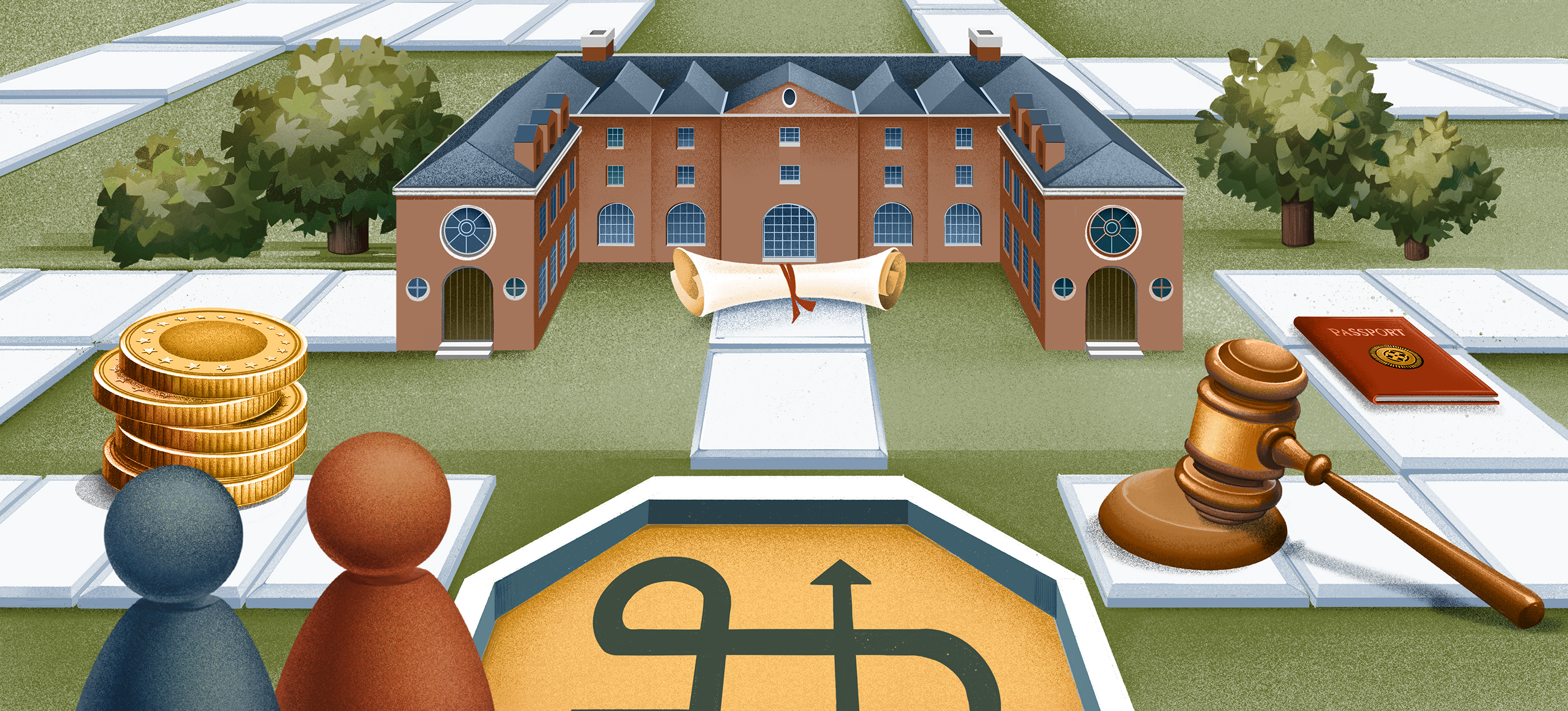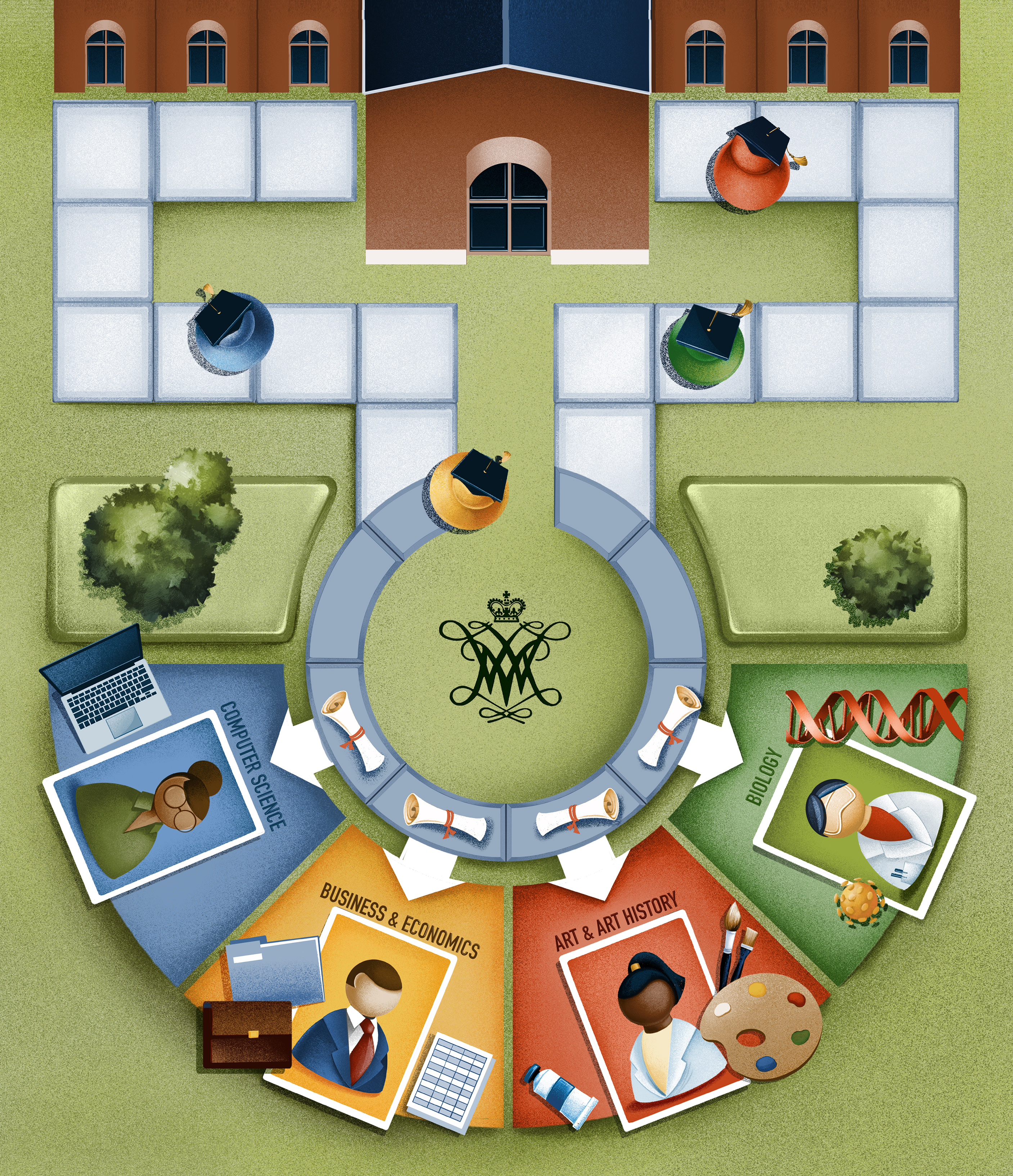Charting the Path

October 9, 2024
By
Catherine Tyson ’20
Artwork
Chiara Vercesi

Rising costs. The prolonged effects of a global pandemic. College closures. These concerns and more have sparked debate about the future of higher education. Part of the conversation centers around enrollment — will America continue to value higher education, and how will demographic shifts impact the industry? To help answer those questions, William & Mary admission professionals and alumni working in the field discuss enrollment trends. They also provide strategies for how universities can adapt to the shifting landscape and achieve their enrollment goals.
For decades, the number of students enrolled in higher education was on the rise. The National Center for Education Statistics (NCES) shows an all-time high of over 18 million undergraduate students in the U.S. in 2010. More recently, however, these numbers have started to drop. Exacerbated by the COVID-19 pandemic, overall undergraduate enrollment fell 15% between 2010 and 2021 as tracked by NCES. While National Student Clearinghouse data shows enrollment numbers have started to trend upward post-pandemic, further challenges are forecasted for the long-term trajectory of college enrollment.
Chief among these challenges is a decline of the nation’s 18-year-old population. This demographic is predicted by the U.S. Census Bureau to peak around 2026 at approximately 4.5 million and then to decrease as much as 15% by 2039. This data has given rise to the term “enrollment cliff.” Fewer 18-year-olds means fewer high school graduates — the demographic that drives enrollment for most universities.
While the term “slope” more accurately describes this demographic shift than “cliff,” the message is clear. The pool of traditional college-aged students will grow smaller and competition between universities will become fiercer.
However, this national trend will not impact all universities equally. Location, selectivity, prestige, private versus public status, size, affordability and many other factors will play a role in determining which universities are most affected.
For William & Mary, this demographic shift represents a challenge, but one the university is well positioned to overcome, says Tim Wolfe ’95, M.Ed. ’01, associate provost for enrollment and dean of admission.
“We continue to see strong application numbers and healthy enrollment, bucking national trends and showing the high-quality education we offer is still in demand,” says Wolfe.
Since the start of the pandemic, the university’s application numbers have increased by 25%. William & Mary received 17,798 applications for the Class of 2028; the university enrolled 1,619 students from that pool. Overall undergraduate enrollment increased more than 11% between 2013-2023, during a time when national enrollment fell.
“When it comes to student numbers, William & Mary is in a solid position,” says Wolfe. “However, looking to the future, we are intensifying our efforts to raise the national and international visibility of the university and awareness about the exceptional education and campus community we offer.”
In addition to the demographic changes on the horizon, the gender, racial and economic composition of students entering college today is different from what it was 50 years ago. The majority of college students are now female (59% at William & Mary, in line with the national average). In 2020, white students made up 54% of the national undergraduate population, compared to 81% in 1980, according to data from NCES.
Economic diversity of enrolled students has also increased. 54% of undergraduates in 2020 were first-generation students, according to a report from the Center for First-generation Student Success. These students often encounter more hurdles in the college application and enrollment process than their peers, particularly in affording college. The median income for first-generation students’ parents was $41,000, compared to $103,000 for other students’ parents, the same report shows.
Legislative and judicial changes relevant to college admission could also impact the demographics of future enrolling classes. In 2023, the U.S. Supreme Court ruled that consideration of an applicant’s race in the admission process was unconstitutional. Considering legacy or donor status of applied students was also banned this past March in Virginia. This made Virginia the second state after Colorado to enact such a law. Not long after the Virginia decision, Maryland and Illinois passed similar legislation. Other states are considering taking similar action.
Race, legacy and donor status do not provide any advantage to admission applicants at W&M.
“As a selective institution, William & Mary employs a comprehensive, holistic admission process that allows us to recruit students of strong academic caliber who reflect our values and mission,” says Wolfe. “Our team carefully reviews each portion of the application and evaluates the student based on all the information we have. Essays and letters of recommendation are especially important as they highlight students’ interests, their experiences and what they hope to contribute to our community.”
Recent legislative and court actions have also fueled further scrutiny of higher education as some politicians, pundits and citizens question the political leanings of universities. High-profile student protests nationwide raise questions about universities’ commitment to fostering democratic ideals through respectful debate and open dialogue.
The cost of higher education also is increasingly at the forefront of national discourse. With rising tuition and mounting student debt, more and more Americans are asking the question: Is a four-year college degree worth it? According to a recent Pew Research Center study, 29% of U.S. adults say that it is not. This data follows a multiyear trend starting before the pandemic and accelerating since. In 2016, 55% of Americans believed that a college education was a smart investment. By 2021, that trend had reversed, with 54% saying investing in college is a risk, according to the Public Religion Research Institute. Interest in certificate and trade programs is on the rise as high school students consider other paths post-graduation.
In this turbulent time of shifting demographics and attitudes, what can universities do to maintain healthy enrollment numbers and prove their value? W&M alumni working in the admission field recommend a multifaceted strategy involving outreach, introspection and innovation.
“The bottom line is that universities are clearly going to have to work that much harder to recruit students,” says David Hawkins ’92, M.A. ’94, chief education and policy officer at the National Association for College Admission Counseling (NACAC).
Redoubling outreach efforts and rethinking where that outreach is happening is key.
“Colleges can fall into the habit of recruiting from the same places and treading the same paths from year to year,” he says. “Moving forward, they really need to think about forging into new locations and recruiting students who maybe haven’t seen them before.”
Hawkins believes this could help close the gap between the roughly 60% of high school graduates who choose to go to college and the 40% who don’t. But in a world where many admission offices are chronically understaffed, increased outreach can be challenging and Hawkins encourages universities to leverage partnerships to get the job done.
In the fall of 2023, William & Mary launched the Commonwealth Impact Partnership Program to increase outreach to and recruitment of students who face financial challenges to entering college. Through this program, W&M partners with Virginia high school counselors to identify and nominate high-achieving, limited-income and/or first-generation students for a scholarship and mentoring program at the university that covers the full cost of in-state tuition and fees. This new program helped lead to a 28% increase in the number of enrolling first-year Pell Grant recipients for the Class of 2028 compared to last year. In total, 20% of incoming first-year in-state students are Pell Grant recipients.
Alumni are another key group that can help universities increase their outreach, according to Hawkins. “The admission office can’t be everywhere at once,” he says and recommends that universities “activate their alumni networks” to be ambassadors for their alma mater.
Attending college fairs and writing congratulatory postcards to admitted students are just two of the ways W&M alumni can interact with students through the university’s Admission Volunteer Network.
For Justine Whitfield M.Ed. ’10, Ph.D. ’16, director of admission at Meredith College, a private women’s college in Raleigh, North Carolina, outreach with prospective students needs to be as early and engaging as possible.
“Think about designing summer programs that enable high school freshmen and sophomores to meet your students and faculty,” she says. “This gets high schoolers excited about college from an early stage, and when they begin applications, they’ll have your name in mind.”
For the second year, William & Mary hosted the Building Leaders for Advancing Science and Technology (BLAST) program. Born out of a partnership with the Virginia Space Grant Consortium (VSGC), BLAST brings ninth and 10th-grade Virginia high school students to W&M for a four-day deep dive into science, technology engineering and math (STEM). BLAST students got hands-on experience in synthetic biology, optics, microcontrollers and soldering as well as attending a careers-in-STEM panel and touring special locations on campus. Read more about BLAST on page 12.
Beyond BLAST, William & Mary offers opportunities such as Camp Launch (a two-week residential program with courses in STEM, writing and personal development) and campus visits for middle school students via partnerships with the State Council of Higher Education for Virginia and local school districts.
When it comes to opening the college door to more students, spreading the message that all are welcome is key, especially after the Supreme Court decision on affirmative action, says Whitfield.
“Post-Supreme Court decision, we need to be even more intentional about making sure students of all backgrounds can see themselves on campus and that they see themselves in other students on campus,” she says. “So for me, it’s a lot about representation.”
Whitfield recalls her student experience at William & Mary and the meaning behind the university motto “those who come here belong here.”
“You could really feel that on campus,” she says. “It was authentic and reflected in the way students interacted with one another. When you got there, you were part of the Tribe.”
Adapting admission protocols can also help remove barriers and increase applications, says Robyn Lady ’90, a longtime college admission advisor and member of the Fairfax County School Board in Northern Virginia. She is encouraged by the shift toward test-optional policies adopted by numerous universities during the pandemic. From Lady’s perspective, this change has a dual benefit — it could combat the demographic decline by increasing the applicant pool for selective universities and it gives many bright students a better shot at being admitted.
Following a three-year pilot program, W&M decided to move test-optional indefinitely in 2023.
“We see no difference in retention rates between students who apply test-optional and those who don’t, and average GPAs are within 0.25 for the two groups,” says Wolfe. “Moreover, the flexibility of test-optional increases our ability to recruit talented students who may not otherwise envision themselves at the university, including those who may be the first in their family to attend college.”
While test-optional policies can encourage more applicants, increasing financial aid to first-generation and limited-income students helps turn those applicants into enrolled students.
“We are continually working to increase affordability and access to students who come from under-resourced backgrounds,” says Wolfe.
In addition to the Commonwealth Impact Partnership Program initiated this year, William & Mary has been committed to covering full tuition and fees for all in-state Pell Grant recipients since the 2023-2024 academic year. The university also holds a longstanding commitment to meet 100% of the demonstrated financial need of in‑state Virginia residents. These initiatives have garnered national acclaim. W&M consistently ranks among the nation’s top 20 best-value public schools according to the Princeton Review.
With strong support for in-state students, W&M is looking to increase scholarships for out-of-state students.
“As we face the demographic decline, W&M’s ability to offer financial aid to out-of-state students is critical,” says Wolfe. “This is an area where we still have important progress to make.”
Thanks to the generosity of a donor couple, the university announced a $2.5 million endowment that began supporting a new Lighting the Way scholarship for a limited number of out-of-state, Pell Grant-eligible students this fall .
“This scholarship takes us one step closer to our priority of increasing aid to out of state students. Further philanthropy is needed to help move the needle,” says Wolfe.
Timely reception of financial aid information is necessary for students to make an informed enrollment decision. Despite significant changes to the Free Application for Federal Student Aid (FAFSA) in 2023-2024 that delayed many schools’ offer letters, the W&M Financial Aid Office still succeeded in delivering financial aid packages on a comparable timeline to previous years. Continued uncertainties with the FAFSA are predicted for the upcoming application cycle, increasing the need for admission and financial aid offices to work efficiently and communicate effectively with prospective students.
As universities look to compete with the nearly 4,000 institutions of higher education in the U.S., mission, vision and values are becoming increasingly more important — not as boxes to check, but as authentic articulations of community and shared purpose.
“Colleges really need to think about how they are differentiating themselves,” says Lady. “You can’t have the same mission and vision you had 10 years ago. We are living in a different country and a different world.”
Recent events bring this need to a new level. With emotions running high on campuses across the nation, parents are interested now, more than ever, in the culture and goals of the institutions to which they are considering sending their students.
“One of the primary goals of a liberal arts education is to develop independent, critical thinkers who are engaged in the world around them,” says Ginger Ambler ’88, Ph.D. ’06, senior vice president for student affairs and public safety at William & Mary. “This requires curiosity, active listening, discussion, debate — all key elements for a robust exchange of ideas. It also requires respect, a value of paramount importance in our community.”
Grounded in the university’s values, William & Mary developed its Democracy initiative as part of the Vision 2026 strategic plan. As a co-leader of this initiative, Ambler helps organize the university’s efforts to promote campus discussion of important issues with civility and respect. To learn more about the Democracy initiative, see page 36.
The COVID-19 pandemic also challenged college campuses to redefine their residential culture in the midst of turmoil, and those effects are still being felt.
“Post-pandemic we see different types of students, those who prefer online learning and those who still look for and crave that in-person educational experience,” says Chris Rey J.D. ’10, president of Barber-Scotia College in Concord, North Carolina, founder of the HBCU Internship Foundation and a former member of the W&M Alumni Association Board of Directors.
For William & Mary, the pandemic reinforced the importance of personal connection and social interaction.
“At W&M we prioritize relationships. The conversations and interactions that students have with one another and with W&M professors and staff are among our community’s greatest strengths,” says Ambler.
As college costs increase, career outcomes are taking on mounting importance for parents and students comparing the cost of college with post-graduation income levels.
For Donna Eddleman Ed.D. ’10, assistant vice president and dean of students at Hendrix College in Conway, Arkansas, a focus on the future is critical as universities prepare graduates for success in the job market.
“Universities need to work with industry and global leaders to offer unique and substantive opportunities — job placements, internships, innovative and entrepreneurial environments — that demonstrate a commitment to student success and prepare competitive graduates for future professions,” she says.
With 93% of students employed or in graduate school within six months of graduation, William & Mary’s focus on careers is producing results. A key part of this success is the university’s focus on internships.
As part of Vision 2026, W&M set a goal to provide the opportunity for a funded internship or other applied learning experience for every undergraduate. Thanks to generous gifts from donors, the university can now fulfill that goal. The Princeton Review has ranked William & Mary in the top 10 public universities nationally for internships for four years in a row.
“Internships and applied learning roles are a natural extension of the W&M experience through which our students strengthen their core career competencies in a professional environment,” says Kelly O’Shaughnessy ’05, director of career readiness pathways at W&M’s Cohen Career Center. “These experiences help our students solidify their interests on a deeper level, make more informed career choices and begin to build their career connections, expanding the William & Mary network.”
As demand for jobs in data science grows, the university is preparing to launch the School of Computing, Data Sciences & Physics, slated for 2025.
“Artificial intelligence is just one way technological advancements are rapidly transforming the job market across all industries,” says O’Shaughnessy. “At W&M, our goal is to prepare students for a lifetime of career transitions as productive citizens of the 21st century.”
As the population of 18-year-olds decreases, Hawkins and Whitfield point to the importance of thinking beyond the traditional student in outreach and recruitment.
“Data shows that there are two increasingly important populations of students — students transferring from two-year degree programs to four-year institutions and adult learners coming back to education after spending time in the workforce,” Hawkins says.
An adult learner herself, currently working on her online M.B.A., Whitfield emphasizes the importance for universities to tailor their offerings to students who are older than 25.
“These are people with kids, working jobs, sometimes unable to come physically to campus. How can universities utilize online platforms and campus spaces to address their unique needs and increase flexibility?”
Offering online graduate programs and certificates in business, education and law, William & Mary is looking to meet the needs of this population. The university places particular emphasis on delivering education that serves active-duty service members and military veterans, an initiative managed by the Office of Military & Veteran Affairs. William & Mary is ranked in the top 15% of universities nationwide by G.I. Jobs Magazine for the university’s commitment to the nation’s active-duty service members and military veterans.
Monica Pinier, W&M’s senior assistant dean of admission, focuses on advising and welcoming the 150-200 transfer students that matriculate to William & Mary each semester. Many of these students come to William & Mary through partnerships with Virginia’s Community College System (VCCS) and Richard Bland College, which guarantee admission if a student fulfills certain criteria.
“Community college can be a solid path to William & Mary for many students,” says Pinier. “W&M has a dedicated orientation and specific resources for transfer students to ensure they feel the message ‘you belong.’”
At professional development sessions over the summer, Peter Atwater ’83, P ’17, P ’20, a William & Mary adjunct faculty member and author of “The Confidence Map: Charting a Path From Chaos to Clarity,” spoke about the importance of “becoming comfortable operating in a world that inevitably brings us moments of uncertainty.”
Through 300 years of global conflict, technological revolution and social change, William & Mary has withstood the test of time. The key to that success has been understanding the present moment while seeing the possibilities ahead. Harnessing that strength and the bonds of a close-knit community, the university will continue to meet the challenges of the next three centuries.






